To channel Richard Nixon, “I am not a cook” – or perhaps I shouldn’t make jokes that are even the slightest bit political right now. Sorry. Anyway, I’m really not a cook. I can make some things. John has complementary cooking talents (especially useful after I run a long way and prefer to be sitting down afterward). We’re fans of Trader Joe’s ready-to-sauté meals such as their Japanese Fried Rice.
So we don’t have highly specific needs when it comes to cooking. We have no particular attachment to gas burners, and switching to electricity for all of our cooking sounded straightforward. We had heard good things about induction (for more details, this website has some good information) so we decided to buy a single induction cooktop and try it out.
We liked it! Again, we’re not picky when it comes to heating up food. Hot is good. Fast is nice. Evenly cooked is great.
The one caveat with induction is that only certain pots and pans will work. If a magnet sticks to the bottom, it will likely be fine. Otherwise the physics just doesn’t happen. How’s that for a technical explanation? See the link a couple paragraphs back if you want more.
OK, so we needed to figure out if and how we could change from the propane stove to all-electric cooking. Here’s what is working for us so far.
For starters, coffee. All good things begin with coffee. No one probably cares about the specifics, but we drink decaf, a strong dark roast is great, and flavoring with things like pecan or chocolate is fun when possible.
We’re also a fan of Philz Coffee and pour-overs, having bought a Clever coffee dripper a few years ago. Our friend Kathy recently suggested a pour-over kettle, and when I found one that works on induction, it seemed like an excellent thing to try. Yes, it is wonderful!
Welcome, kettle:
Here is a link if you’re interested in one like this (side note that I have not set up affiliate links with Amazon, but perhaps in the future if/when our site starts generating more traffic): Java Shield Pour Over Kettle
And the single-burner induction cooktop, super handy for trying this out in small doses to see if we liked it (and there are various other versions available): iSiLER 1800W Sensor Touch Electric Induction Cooker
My Hardrock mug (no link available for that one!), the Clever coffee brewer, and the induction-heated kettle (and an unrelated Camelbak bladder):
For sure, a normal coffee maker would work well too. They already run on electricity and I’ve gotten good at playing with coffee/water ratios to produce the strong stuff. We even had one in Howie for a while, but it takes up space and requires some TLC when driving. At the time we were also trying to go more “off-grid” and it was easy to boil water on the stove for pour-overs. So we gave the coffee maker away.
In any case, step 1 (produce coffee) was complete. And delicious.
Last June I ran a very basic test with our old 12V lead acid batteries (~205 amp-hour capacity). I boiled water in the pour-over pot using induction to collect some data:
~3000 feet elevation (near Bend, Oregon), 60 deg F air temperature
With the inverter on, the battery meter showed 12.4 Volts, 3.8 Amp baseline draw, 87% full battery
~24 oz water in the kettle
With the cooktop turned on and set to 380 deg F, the meter shows it pulling 108 A with the battery at 11.1 V
Time to almost boiling = 4 minutes and 30 seconds
Water temperature = 60 deg F to start, 170 deg F to end
When done, the battery = 12.3 V, 83% full
Pretty quick for heating water, which means the coffee is ready without much delay.
I cycled through some of the cooktop settings to read the current it pulls (these are all with the 12 Volt battery system):
260 deg F — 62 Amps (740 Watts)
300 deg — 107 A (1280 W)
340 deg — 107 A (1280 W)
420 deg — 132 A (1580 W)
460 deg — 132 A (1580 W)
On a different day, I tested the cooktop using AC power and a Kill A Watt meter (which, by the way, is very handy for testing power usage of appliances). In addition to the temperature settings, the cooktop can be set based on power settings from P1 to P9. In fact, it defaults to P6, so it’s just easiest to leave it on the P’s instead of switching to temperatures.
Here are the numbers (for 120 V AC power):
P1 — Cycles on/off, 2.5 A (300 W)
P2 — Cycles on/off, 4.7 A (560 W)
P3 — 4.7 A (560 W)
P4 — 6.8 A (810 W)
P5 — 8.3 A (1000 W)
P6 — 10.1 A (1210 W)
P7 — 11.7 A (1400 W)
P8 — 12.4 A (1490 W)
P9 — 13.1 A (1570 W)
Early on we were focusing mostly on amperage, but when John later added 24 volts into the system with the lithium batteries we realized that it was quickly becoming even more confusing than it was with 12 volt DC and 120 volt AC comparisons. Eventually we started talking mostly in wattage, except in cases where we needed to know the current limits for wire sizing and such.
Anyway, that’s some initial data for anyone running numbers for their own mobile setup.
Now for a detour into the pots and pans side of things. Remember when I mentioned that the cookware needs to be magnet-stickable? Well, that comes into play in the next little story.
I searched around online for a new cookset. When I found one that is stackable AND induction-compatible, I was excited! How to solve two things at once – freeing up a bunch of space in our cupboard and converting a lot of things to induction.
Home Depot had a Magma set for sale (but I won’t link to it yet, just a second), stackable and “Induction Compatible” as it says right on the box:
Home Depot is a good option because we can order items for pickup. One challenge of traveling is ordering packages (a whole ‘nother topic that doesn’t really fit into an “all-electric” blog, but ping me if you want my comments on ways to work around it). Anyway, we ordered the pots, picked them up, brought them home, and immediately tried a magnet on it. Oh, first John disassembled the entire box into individual cardboard pieces for recycling…
Then the magnet didn’t stick. Hmm? And the induction cooktop didn’t recognize it as induction-compatible. Luckily we had already proven that the cooktop works just fine (it boils water in the kettle). Magnet on the kettle? Sticks. Magnet on the pots? Nope!
I searched around for help, messaged Home Depot and directly with Magma, and got some assistance from the website Magnetic Cooky (thank you!). They were all helpful, and we all eventually came to the conclusion that the box label and the Home Depot description were both incorrect. It was not induction-compatible.
Crestfallen… I really wanted a stackable induction cook set for Howie.
But wait! There IS a Magma cook set that is stackable AND induction-compatible AND actually labeled correctly. And Home Depot is awesome about returns (even in an entirely retaped-together box). Soon we had the right set in our hands, and voila:
This is the “Magma Products, A10-363-2-IND, Gourmet Nesting 7-Piece Stainless Steel Induction Cookware Set with Ceramica Non-Stick” – and the link to it on Amazon. It appears that today Home Depot has only the 10-piece version, which I’m sure works too. The 7-piece set is already fairly heavy, so I’m glad we have that one.
Home Depot fixed the description for the previous set (it was “Marine” quality and not the proper materials for induction), and I assume Magma is working on their packaging as well. Thank you all for the quick turnaround in resolving the issue.
After all that, I’m thrilled to report that everything works, the pots stack and store nicely, and we have been busy cooking away.
Here are the small pot (with detachable handle) and the big pot:
The cover becomes a flat pan (the handle fits the pan too). The larger lid fits both the big pot and flat pan. I also saved a glass cover from our previous skillet (not pictured here) since it’s the same size – hey, a bit of standardization, nice. The set includes some pads you can use when stacking them:
The working cookware/induction system allowed us to give away a few things, including 2 frying pans, 2 saucepans, 1 stock pot, and a large sauté pan. So much more space available!
I thought I might miss having extra room in the biggest pots for making soup and other bulkier dishes, but so far we aren’t feeling limited by pot size. And it’s great having a detachable handle – now the pots and pans fit into the sink for easy washing.
One of my favorite things about induction cooking is that heating is evenly distributed across the bottom of the pan. This seems to cook more consistently than other methods I’ve used (electric coils, gas). I might be making things up, but food even seems to taste better. Some examples – perfectly cooked salmon, rice, quinoa, macaroni and cheese.
A few random photos of other things we have cooked with induction, just because I sometimes get “camera happy” when I’m in the groove with all-electric reporting.
Hard-boiled eggs:
Dumplings (vegetarian, Trader Joe’s):
Something I call a “melange”, a concoction I’ve been playing with lately that involves a grain, a protein, some vegetables, and a mixture of whatever seasonings I feel like throwing in. This one has wild rice, Beyond Meat sausage, carrots and peas, and probably some combination of minced garlic, ginger, pepper, and minced onions:
Just for kicks, another day of melange – with the rest of the wild rice, Trader Joe’s faux Italian sausage, colorful cauliflower and carrots, and I think I tossed in some pesto, oregano, minced garlic (because you can never say no to garlic), and Tutu’s seasoning from Hawai’i:
Pancakes! These are simply the best pancakes ever, Aretha Frankenstein’s from Chattanooga. So good. We’ve been picking up boxes from the Publix grocery stores in Tennessee and nearby. Also available online!
We just purchased a skillet with lower sides to make it easier to cook pancakes and similar things. And now that we are used to having pans with detachable handles, the choice was straightforward:
Suffice to say, we have been having fun with induction cooking.
In the midst of all that confusion leading up to the solution, I received a suggestion – we should try an induction diffuser plate that might allow any pots and pans to work on the induction surface. This could be a way to keep your current cookware and switch to induction. So I got one to play with. I don’t have a photo because I decided it takes way too long to heat the food and completely defeats the purpose (and so it’s no longer with us).
One of the reasons I experimented with the diffuser plate was popcorn. We love to make popcorn in a Whirley Pop popper. We were gifted one, used the heck out of it, and even bought a second one when we lived on Maui for 6 months. Fast, high heat from a propane burner works well for popping corn. A diffuser plate is limited to medium heat, so it was not a popcorn solution.
Perhaps we would need to find another way to make popcorn.
Or! Perhaps the Whirley Pop induction model would be the ticket:
As much as we want it to work, and we haven’t given up on it yet, it does have some issues. The big one is that the whirley alignment is crappy. Our non-induction one was great, very smooth and easy to turn. This one jams up with even the slightest load. We’re not sure if it came from a bad batch or if the design has been changed (for the worse). John is still fiddling with the parts to try to improve it.
We also mismanaged the temperature on the popper while creating a recent batch, burning the bottom popcorn pieces. The charring is not very cleanable.
So it isn’t clear that this is going to work, although we did make a successful batch a couple days ago. We might have to do some more research into all-electric popcorn popping. This should be solvable. I’ll update you if/when I find a better solution.
In addition to all the fun playing around with induction, we made a couple other changes/additions to our cooking stable.
First, our old (original) microwave was on its last legs. The turntable didn’t always rotate. It was loud. We were happy to find a small replacement for it:
Since the new one only microwaves (no grill or convection), and because I am on a multi-year bagel kick which requires some kind of toaster device, we also got a small toaster oven. Useful for non-bagel items too!
And finally, we have heard many good things about the Instant Pot. So we bought one. It has several functions including pressure cooker, slow cooker, steamer, yogurt maker, warmer, and goodness-knows-what else.
I can vouch for the pressure cooker as a way to cook rice in way less time. We’re looking forward to trying it for beans, hard-boiled eggs, vegetables, and whatever else it might help us with. Lots to experiment with!
Some power numbers for our cooking appliances:
Induction cooking = 300 to 1580 Watts
Microwave = 1550 W (900 W output rating)
Toaster oven = 1050 W
Instant Pot for pressure cooking = 660 W
I’m planning for more tests – and if you have suggestions or requests, send me a note. Some ideas:
- I missed the chance to compare “time to boil” for induction vs. gas burners. If anyone has data, I’d be interested in your experiences.
- Power draw for other modes of the Instant Pot
- Compare the Instant Pot to induction for cooking rice (time and energy required)
- Compare pot sizes on the induction cooktop – do you lose efficiency with a small pot on a larger ring? Try heating the same amount of water in different pots, see how much energy and time is required for each
- Compare energy and requirements to heat water using different induction power levels
And now, I think it’s time for lunch.

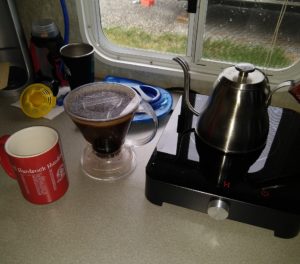
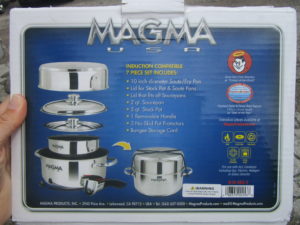
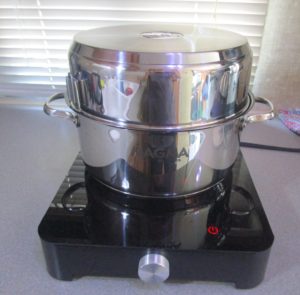
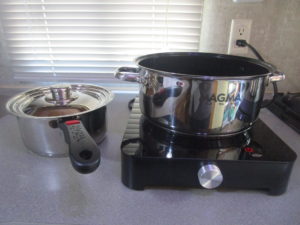
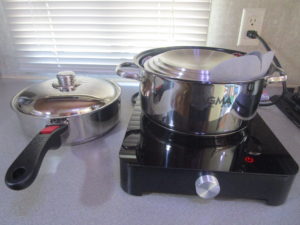
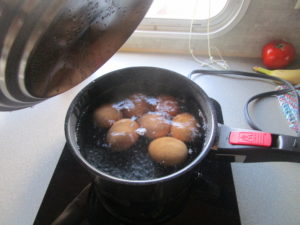

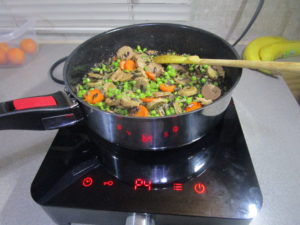
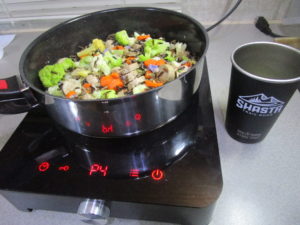
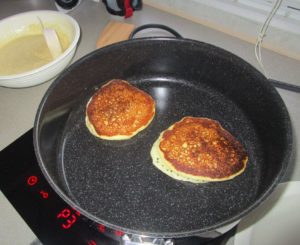



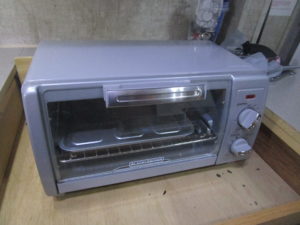

Hi Marcy, I love your detailed reporting. All those pictures are making me hungry 😉
I love my single burner induction cooktop and I also own an InstanPot and love it too !
Now, I would like to ask the following question: Which of the following methods for boiling water would you expect is more efficient (faster and uses less electricity), using an induction hot plate or an electric kettle? It turns out that most inexpensive electric kettles are more efficient than using an induction hot plate, because while they use a heating element, the heating element is mostly heating water, not the container.
Here is an experiment I just conducted to compare the performance of my 7-yr old Aroma model AID-506 single burner induction cooktop ($50 at Costco) and my 1-yr old Hamilton Beach Type K47 Electric Kettle ($20 at Costco) boiling 3 cups of water from room temperature:
The Electric Kettle took 2 min 44 seconds to bring 3 cups of water to a full boil drawing 12.12 Amps at 120 volts (1454 Watts) or 0.066 kWh of energy.
The Induction cooktop took 4 min 44 seconds to bring 3 cups of water to a full boil drawing 11.60 Amps at 120 volts (1392 Watts) or 0.110 kWh of energy.
Even if my old Aroma induction cooktop is a bit tired, it is hands down less efficient than the electric kettle.
So, if you don’t use an electric kettle in your off-grid system, you should try it.
Cheers,
Marc
Hi Marc!
Your comments are super helpful, please keep them coming.
We love electric kettles, and your analysis prompted us to buy one yesterday. It has hardly any weight and I’m sure I can find a place to stash it. I’ve added it to my list of tests! And I’ll try it for my coffee this morning.
Now if you can just find us some electric air heating method that uses half the power of our little ceramic one…
Thanks Marc!